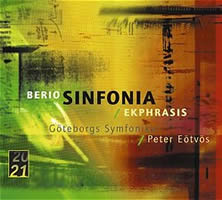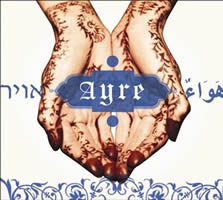“This Represents At Least a Thousand Words I Was Not Counting On”
|
Grant Chu Covell [November 2005.]
Luciano BERIO: Sinfonia (1968); Ekphrasis (Continuo II) (1996). London Voices, Göteborgs Symfoniker, Peter Eötvös (cond.). DG 00289 477 538-0 (http://www.deutschegrammophon.com/). This new recording of Berio’s ambitious Sinfonia is the best yet. Boulez’s aggressive 1984 reading (released ’86 on Erato 2292-45228-2) has been upstaged. Eötvös’ gentler hand brings clarity. The low winds and electronic instruments are more clearly discerned, rapid passages come off precisely, and the texts are considerably more intelligible. The orchestra consists of violins in three groupings, electric piano and organ, and ample percussion. Fascinated by the Swingle Singers who had so stylishly melded bop with Bach, Berio integrated eight amplified soloists who add multilingual vocalizations, scat singing and artily declaimed texts. Fractured phrases from Lévi-Strauss’ The Raw and the Cooked infiltrate the first movement and reappear elsewhere. Movement two incorporates Berio’s memorial to Martin Luther King, the vocalists exploring the phonemes of the slain leader’s name. Originally the Sinfonia’s close, the fourth movement keeps to a few syllables. Berio considered the more satisfactory concluding fifth movement a musical analysis of the preceding four. Commissioned for the New York Philharmonic’s 125th anniversary and dedicated to Bernstein, Sinfonia was a watershed in Berio’s output, generating techniques and ideas he would explore throughout the coming years. The composer led the Oct. 10, 1968 New York premiere, adding the now final movement shortly thereafter. Bour premiered the five-movement version at Donaueschingen, Oct. 18, 1969. Its high spirits (Ward Swingle flubs a few lines) are captured on the “Donaueschinger Musiktage 75 Jahre” set (col legno WWE 12CD 31899). The third movement made this piece famous, though, in point of fact, Sinfonia is discussed rather more than it is heard. For the central movement, “In ruhig fliessender Bewegung,” Berio appropriates the entire scherzo of Mahler’s Second Symphony, “Resurrection,” and layers an expertly constructed collage through it. Quotations from Bach, Beethoven, Berlioz, Brahms, Debussy, Ravel, Richard Strauss, Schoenberg, Berg, Webern, Hindemith, Stravinsky, Pousseur, Boulez and Stockhausen weave throughout the Mahler foundation. Intending to incorporate music which influenced him (Berio originally considered using the last three movements of Beethoven’s Op. 131), the composer used scores he found at a public library while on vacation, in addition to those he had carried in his luggage. (Imagine packing Boulez and Stockhausen in the same valise!) As if the onslaught weren’t enough, one of the two tenors becomes a ringleader, declaiming pithy slogans, protest chants, and chunks from Beckett’s The Unnamable. The quotes, verbal and musical, are somewhat altered. A few of the movement’s most memorable lines: “But I must have said this before, since I say it now,” “This represents at least a thousand words I was not counting on,” and “And after each group disintegration, the name of Majakowsky hangs in the clean air” (this last purportedly referring to a composition by Globokar). Puns herald each quotation’s placement. In the rapidly whirling text, the orchestra answers “gift” with a blasting chord from Boulez’s Don. (A commendation goes to the listener who recognizes that!) “[L]owing cattle, the rush of the stream” summons Beethoven’s Pastorale, “Daphne [sic!] and Chloé” calls up the obvious Ravel, “ocean” brings on La Mer, at “blood,” Wozzeck drowns, etc. At one point the ringleader suddenly realizes that he is not alone: “… well, well, so there is an audience….” Later he names each vocalist, refers to another piece on the same program (“And tomorrow we’ll read that [Berio’s Ekphrasis] made tulips grow in my garden and altered the flow of the ocean currents”); at the whirlwind’s close he thanks the conductor. It is good to know that all these years I’ve been pronouncing Eötvös correctly. While it’s probably true that we hear music differently, few pieces I can think of so uniquely trigger individual listener responses. For example, I readily note Der Rosenkavalier and the French works, but the Hindemith, signaled by “academic exercise,” and Pousseur quotes are lost on me. Apparently Berio mimics Pousseur’s instrumentation and doesn’t actually take any musical material. A perusal of Schoenberg’s Op. 16 confirms Berio’s reuse of the fourth movement’s opening brass salvo. (It’s difficult to hear the vocalists’ corresponding “peripetie.”) I’d like to think that some of the suffocating clusters are from Zimmermann’s Die Soldaten, but David Osmond-Smith’s extensive analysis, Playing on Words (Royal Musical Association, 1985), doesn’t confirm this. My experience of this music has grown reflective. Berio’s scherzo was quite the perfect college-freshman game of identifying as many quotes as possible. Now, at least for me, the outer movements hold greater interest, not the least of reasons being the manner in which Eötvös makes them shine. Outside the central exhilarating flux, restraint is the watchword. The second and final movements end on the same chord, and areas of the fourth movement keep to a tight pitch range. The final movement develops and reprises material from the first four, like a troubled memory. In fact, the whole Sinfonia is concerned with memory: memorials, dreams and repetition. Ekphrasis was the composer’s last orchestral composition. Berio spreads gauzy netting through which chords, opalescent smears and scattered gestures shimmer. Subtitled Continuo II, the work recalls Eindrüke (1973-74) which capped Erato’s Sinfonia release and itself fused Bewegung (1971) and Still (1973). As in the original 1989-91 Continuo (Teldec 4509-99596-2), Berio rearranges the musicians’ seating, abandoning non-pitched percussion. The composer had been thinking about architectural space when writing Continuo and Ekphrasis. Both works levitate hesitatingly, and Eötvös’ gentle but precise touch works magic.
Frank SCHEFFER: Voyage to Cythera (1999), Attrazione d’Amore (1998). Ideale Audience DVD9DS12 (http://www.ideale-audience.com/). Distributed in the US by Naxos (http://www.naxos.com/). Coincidentally, my reacquaintance with Sinfonia came after a live performance of Louis Andriessen’s 1997 Trilogy of the Last Day. Alter Sinfonia’s fourth movement so that the instrumentation favors winds and e-guitars and Berio’s student could have penned it. (Andriessen did in fact work on Passaggio’s scoring.) The finale’s rapid, gradually overwhelming filigree features patterns the Dutch composer might employ. In Voyage to Cythera, Scheffer’s 51-minute film about Sinfonia’s centerpiece, Andriessen recounts how he brought Swingle Singers’ LPs to Berio’s attention. He considers the movement a clever one-up of other “citation music” then in vogue, especially singling out Zimmermann, whose Musique pour les soupers du roi Ubu (1962/66) scores high as collage. Other coincident listening points to a different faction to which Berio (and Andriessen) may have been reacting: On Sub Rosa SR178, Nam June Paik’s tape collages quote pop music, Petroushka and signature bits from Beethoven’s Fifth and Ninth. A movie about Sinfonia’s collage? Scheffer doesn’t lay bare the work’s secrets. As an introduction to Berio or Sinfonia, it may confuse more than illuminate, though it does capture the chaotic mood. A casually ruminating Berio delivers big artistic thoughts (Sanguineti, Calvino and Eco were close collaborators) and offers nuggets about how the text signals the quotes. The filmmaker pounces upon Berio’s river metaphors (“Mahler is a ship,” and “voyage to Cythera”), as the camera lolls into transitions including duotone water and nature scenes. Scheffer freely incorporates footage of other conductors and composers, explorations which only make sense if you’re already in the know. We see Chailly rehearsing Schoenberg’s Op. 16, Muti discussing the opening of Mahler’s Fourth, and Haitink working up the original Mahler scherzo. Elsewhere Scheffer folds in Schoenberg (I never knew there was film footage!), Stravinsky (accompanied by the perennial Craft), Boulez (at the Don chord, of course), and Stockhausen. We see Berio conducting. He’s stiff, eyes on the score, forcefully cueing instruments, a stark contrast to Chailly, whose relationship with the Concertgebouw is chronicled in the accompanying film, Attrazione d’Amore. Using Mahler’s Fifth as blueprint, Chailly and musicians romance about the Italian conductor’s relationship with the orchestra. There’s some pretty good music-making going on in Amsterdam. This DVD offers Ring, a bonus pieced together from other Scheffer films, which compresses Wagner’s tetralogy into less than four minutes. Among many superimposed vignettes is Berio arm-waving his Sinfonia. One of my college friends, Benedict Weisser, takes an artistic credit.
Osvaldo GOLIJOV: Ayre (2004); Luciano BERIO: Folk Songs (1964). Dawn Upshaw (sop.), The Andalucian Dogs, Tara O’Connor (fl.), Todd Palmer (clar.), Ljova (viola), Erik Friedlander (cello), Bridget Kibbey (harp), Eric Poland, Gordon Gottlieb (perc.). DG B0004782-02 (http://www.deutschegrammophon.com/). Well known is Berio’s taste for reuse and appropriation of his own work and that of others. To the latter category belongs 1964’s Folk Songs, arranged for Berio’s first wife, the famously agile Cathy Berberian. A recent DG recording unites the ever-lovely Upshaw with seven meekly recorded instrumentalists. This neglectfulness dilutes Berio’s straight-ahead settings. Many details, such as the slithering viola and cello in “Motettu de Tristura,” cannot be heard. However, the set’s spryness appropriately balances Golijov’s Ayre, commissioned to be Folk Songs’ companion. In Golijov’s exuberantly diverse song cycle, Upshaw expertly shapes Arabic, Hebrew and Spanish songs. The accompanying ensemble incorporates electronics and a modified accordion as gestures toward popular idioms and ethnomusical correctness. Like Berio’s cycle, Golijov’s is a pretty postcard collection. Berberian’s own Folk Songs recording (RCA 09026-62540-2) and a 1995 release with Luisa Castellani and Contempoartensemble under Mauro Ceccanti (ARTS 47376-2) offer more of a balanced bite.
[More Grant Chu Covell]
[Previous Article:
Kipple 4.]
[Next Article:
Marco Polo’s do-it-yourself Hymnen]
|


